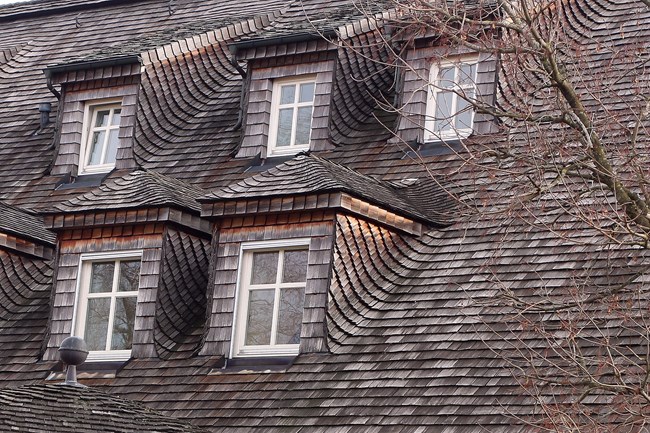The time to repair the roof is when the sun is shining. John F. Kennedy
Article
Recycle Plastic and Rubber Roofing Shingles

The National Park Service’s (NPS) commitment to sustainability extends to buildings and other structures as described in the NPS Sustainable Building Implementation Plan (SBIP). Buildings located within national parks should not only complement their surroundings in terms of aesthetics, they should be constructed and managed in ways that minimize environmental impacts.
Almost every piece of material that goes into the construction of a building contributes to how sustainable the building is. The roof in particular plays an integral role in determining the energy efficiency of the building. In addition, the material the roof is made of, its durability and its recyclability contribute to the building’s environmental footprint.
In the United States, shingles are the most widely used roof coverings. Roofing shingles are made of:
• Asphalt
• Wood
• Slate
• Metal
• Fiber cement
• Plastic.
Asphalt shingles make up about two-thirds of the U.S. roofing market for new construction and roof replacements, as they are relatively inexpensive and last about 20 years on average. They consist of:
• Fiberglass
• Asphalt cement
• Ceramic-coated natural rock
• Mineral filler
However, an estimated seven to ten million tons of asphalt shingle tear-off waste is generated every year. Although the ability to recycle asphalt shingles has advanced for use in hot mix asphalt, most waste asphalt shingles end up in landfills.
Shingles Made From Recycled Plastic and Rubber
These green alternatives to slate and asphalt shingles-made from recycled materials-are 100% recyclable. Since they are relatively new to the market, manufacturers have not proved claims of longevity. However, the plastics and rubber that make up the shingles are strong, flexible and resistant to harsh weather, resulting in tiles that are proving to be very durable.
Discarded materials, like used vehicle tires and even plastic milk bottles, are cut, heated and molded into shingles that look very similar to natural slate tiles. The environmental impact from manufacturing these shingles is unknown, yet repurposing an existing product that can be recycled again follows the basics of cradle-to-cradle principles. For example, since they do not require the inputs and landfilling associated with asphalt or the mining associated with slate, these recycled plastic and rubber shingles have a lower carbon footprint than traditional roofing shingles when considering their full life cycle.
The recycled content shingles are relatively expensive compared to asphalt shingles but are easier to install and more lightweight than slate tiles. As a result, their installation, transport, and maintenance costs are less than for slate, clay and metal tiles.
Can a new synthetic product like these tiles be used on an historic building?
The NPS Technical Preservation Services’ Preservation Brief Number 16 states that substitute materials “…can be cost-effective, can permit the accurate visual duplication of historic materials, and last a reasonable time. Growing evidence indicates that with proper planning, careful specifications and supervision, substitute materials can be used successfully in the process of restoring the visual appearance of historic resources." Historic buildings should consider these tiles because they are fire-resistant, lightweight and duplicate the look of slate tiles.
While their durability is still being proven, roofing shingles made from recycled plastic and rubber appear to be an environmentally friendly alternative to traditional shingles that shows promise and is welcome in the sustainable building marketplace.
Last updated: August 11, 2021
